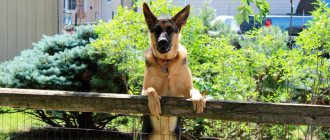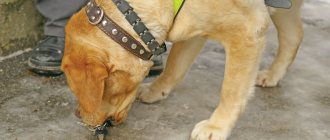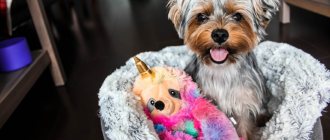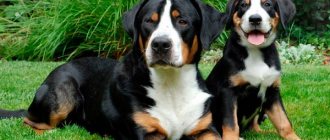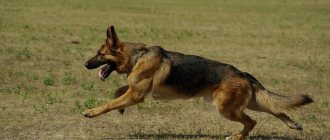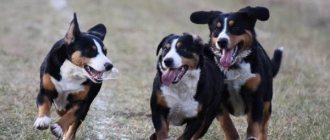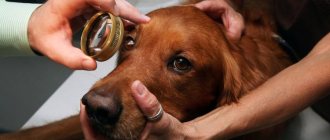General description. A shepherd with the soul of an aristocrat
The Bernese Mountain Dog is a Molosser, a large breed of dog that descended from Egyptian and Assyrian baiting dogs. However, over almost 2 thousand years of formation, they completely lost their hunting instinct.
The Mountain Dog is also called the Bernese Shepherd or Mountain Cattle Dog.
Translated from German, “hund” means dog, and the word “senn” meant Swiss shepherds. But the Bernese Mountain Dogs did not limit themselves to just herding. They were also used for transporting goods and as guards. Although dogs cannot be guard dogs due to their good nature, they are excellent guard dogs. One formidable appearance can scare off ill-wishers.
Progress conquered the highlands slowly. Therefore, Bernese Shepherds transported milk and other products in special carts.
The Bernese Mountain Dog can pull 10 times its weight - up to 500 kg.
Dogs were created to work. Labor is their favorite thing. They are happy to pull the harness and help with all household chores. They need to feel useful. Otherwise the animals will wither away.
Bernese are adapted to life in harsh climates. Powerful bones, strong paws, and thick hair allow them to easily move along mountain ranges and endure cold weather.
Despite their “rural” origins, Bernese Mountain Dogs are not without aristocratic manners. They are unobtrusive and detect the slightest changes in the owner’s mood and well-being.
Even the appearance of a shepherd dog smacks of nobility. You can endlessly admire the light gait, proudly raised head and tricolor coat shimmering in the sun.
Origin of the Mountain Dog. A history spanning two millennia
The Bernese Mountain Dog breed dates back more than 2 thousand years. It was not possible to establish exactly from whom the dogs originated. It is most likely that their ancestor was the Tibetan mastiff.
The ancestors of the Berns came to Europe along with the Roman legionnaires. They took root in the area of the Gotthard Pass in the Alps.
The ancient origin of the breed is confirmed by excavations by Herman Kremer. During an expedition near Zurich, he came across a site of the Helvetii - the ancient Swiss.
An archaeologist has found the skulls of dogs similar to the dogs brought by the Romans. Kremer suggested that these were the ancestors of the Sennenhunds.
Subsequently, the animals were formed in isolation: without admixtures of the blood of other dogs.
At the end of the 15th century, the Berns were almost destroyed. In 1489, the burgomaster of Zurich issued an order - the peasants were to kill all large dogs. Allegedly, they spoiled the vineyards of the feudal lords. But the people rebelled and executed the ruler.
Over their long history, Bernese Mountain Dogs have changed their name several times. At first, they, like all large herding dogs, were called hut dogs. Later, the dogs were nicknamed Dürrbachlers, since the pets were most often found in the vicinity of the Dürrbach farm.
Today's name appeared at the beginning of the 20th century. The first word was fixed in the name of the breed from the canton (city) of Bern. This is how the breeders emphasized the difference between the Bernese and other Sennenhunds.
The struggle for recognition of the breed began in 1900. The battle turned out to be long: the dogs were included in the international classification in 1981, and the standard was adopted in 1990.
Until 1907, only conditional boundaries were adhered to in breeding Berns. Breeders from the city of Dürrbach were concerned about the safety of the breed. Just 3 years later, in 1910, they brought over a hundred representatives to the exhibition.
In the mid-20th century, serious problems arose in the breed. They appeared due to long isolated development and frequent matings. To “refresh” the blood, the owners began crossing Bernese Mountain Dogs with Newfoundlands. This helped strengthen the genotype.
It is interesting that after 2 generations, not a trace of the Newfoundlands remained in the appearance of the Sennenhunds.
Thanks to their spectacular appearance, strong physique, and calm, easy-going disposition, Bernese Mountain Dogs soon became popular in Switzerland and neighboring countries.
In 1936, breeders from Great Britain and the USA drew attention to them. At the same time, an American breeder brought representatives of the Bernese Mountain Dog to the state of Louisiana and registered the breed.
During World War II, breeding Mountain Dogs in Europe was problematic. However, the war had no effect on the breeding of the breed in America.
In 1968, the American Bernese Mountain Dog Club was founded for the first time. At first it consisted of 62 members and 43 dogs. Three years later, the number of participants exceeded one hundred.
Nowadays, burns are practically not used for work purposes. They became companions. Dogs get along well in families with children and the elderly.
We recommend reading: TOP 8 dogs for a private home
Origin
This breed began to be bred not so long ago - at the beginning of the 20th century in Switzerland, in the city of Bern.
It is believed that Bernese Mountain Dogs, like all Molossians, owe their origin to Tibetan Mastiffs. The word "Sennenhund" in the name of the breed comes from the German "sene" - alpine pasture, and "hund" - dog.
Initially, it was a herding breed, intended primarily for guarding sheep. Due to its strength and endurance, the Bernese Mountain Dog was also used as a draft animal.
Today, the Bernese Mountain Dog breed has gained popularity around the world not only as a working animal, but also as a companion dog. What makes these beauties especially attractive is their outstanding external qualities.
Standard
Today they adhere to the FCI standard No. 45 of 2003. He places mountain herding dogs in Group 2, Section 3 - Swiss Mountain Dogs.
The description of the Bernese Mountain Dog standard is quite conditional. What comes first is not individual indicators, but a proportional physique and a stable psyche.
At the discretion of the judges, a representative with minor deviations from the standard may participate in breeding and exhibitions if he is healthy and harmonious.
Size
The height of males varies from 64 cm to 70 cm, females - from 58 to 66. Weight also varies greatly: 38 - 50 kg for boys, and 36 - 48 kg for girls.
Frame
Durable, strong, with well-developed muscles. The Bernese Mountain Dog is rather stocky, but not boxy. The chest is deep, ending at the elbows. The stomach is not tucked in.
Head
Large, medium length. Scissor bite. A characteristic feature is “dry” shaves, lack of drooling.
The nose is pure black, without pigmentation. The eyes are brown, almond-shaped. The ears are triangular, slightly rounded at the ends, set high, and hang along the head when the dog is not moving.
Paws
Straight, of sufficient length, parallel to each other. Fingers are gathered into a ball.
Tail
Thick, powerful, pubescent along the entire length. When moving, the Bernese Mountain Dog holds it suspended, slightly lifting the tip upward. The tail should not curl or droop over the back.
Wool
Long, thick, with dense undercoat. It can be straight, with a slight wave.
Color
The main color is black. Above the eyes, on the cheeks, all paws, under the tail, and chest, a brown-red tan is required. There are white markings on the forehead, throat, and chest. It is desirable that they also be on the paws (but not above the middle of the pastern), and the tip of the tail.
The defects for which the Bernese Mountain Dog is disqualified include:
- bifurcated nose;
- atypical color;
- Blue eyes;
- curled tail;
- weak bones.
Bernese Mountain Dog
Maria Sotskaya
From the standard Dogs of this breed have a classic black and tan color with white markings, the size and shape of which are quite strictly regulated. The Bernese Mountain Dog should have a white chest, a symmetrical white pattern on the face, and white paw tips. Let's say the end of the tail is white.
The main color genes of the Bernese Mountain Dog: asa (black-backed) – determines the formation of a non-standard black-and-white color. In a modified state, it can occur in dogs that are too black or have too long tan marks; and t – (tan) determines the development of tan color (black & tan); B – determines the synthesis of black eumelanin. Present in all representatives of the breed; b – determines the synthesis of brown eumelanin, promotes the formation of a non-standard brown and tan color; C – (full color) is present in dogs of all colors of normal intensity; c (leucism) – absent in the gene pool of this breed; D (color of normal intensity) – determines the normal density of pigments in all layers of the hair. Promotes the development of color of normal intensity. Present in all representatives of the breed; d – (weakening of color) – absent in the breed; E (distribution of eumelanin throughout the dog’s body) – present in all representatives of the breed; e (prevents the spread of eumelanin throughout the dog’s body) – absent in the breed; G (age-related lightening of color) – absent in the breed; g (absence of age-related lightening) – present in all representatives of the breed; K (dominant solid color) – absent in the breed; k (allows alleles of locus A to manifest) – present in all representatives of the breed; S (color without spots) – causes the formation of a solid color without spots, absent in the breed; s (white spotting) – causes the presence of white spots, present in all representatives of the breed; T (speckled) – causes the development of dark speckling on white marks, which is undesirable for the breed; t (absence of markings) – present in most representatives of the breed.
Tan color
The tan color, also called the “tan” color (from English - black & tan) or “phantom”, always has very definite, distinct outlines. The scorch marks have a very specific pattern and are located in strictly defined places. Symmetrical tan spots - with clear boundaries, pure red or red color, strictly defined pattern, without intermediate transitional tones and without marks. They are located on the cheeks and eyebrows of the muzzle, under the larynx, two triangles on the chest, on the inner surface of the shoulders and thighs, on the metacarpus, metatarsals, paws, and also around the anus.
Puppies of tan dogs are born with a pronounced pattern, which with age only slightly expands and acquires greater clarity of outline.
The color-forming genes for tan color are recessive a t a t and kk .
If a dog has genes that determine the synthesis of black eumelanin ( B ), a black and tan color is formed, and if there are alleles that determine the synthesis of brown ( bb ), a brown and tan color is formed. It is occasionally found in some breeds related to the Bernese Mountain Dog, particularly the Appenzeller Mountain Dog.
The intensity of tan color depends on a number of genetically determined factors. It can range from chestnut red to light yellow.
The tricolor color typical of the Bernese Mountain Dog is formed by combining black and tan with genetically determined white spotting.
White spot
White spotting occurs in dogs much more often than it seems at first glance, and has a very wide variability. A genetically spotted dog may be solid color with a few white hairs on the chest or be almost white with a small dark spot at the end of the ear. This spotting is caused by a number of recessive genes from a series of multiple alleles related to the S . These genes cause depigmentation or, in other words, “pigmentation gap” in different areas of the dog’s body. The spots appear strictly naturally.
First of all, a white spot appears on the chest, then on the ends of the paws, chin, scruff, end of the tail, etc. - in a certain sequence.
The extent of depigmentation zones depends on a number of genes.
S gene is responsible for the development of a solid color without spots. s gene in double set promotes the development of white spots.
Some researchers suggest the presence of a whole series of genes that contribute to the formation of white spotting - si , sp , sw - which are not completely dominant over each other.
Molecular genetic analysis confirms the presence of different genes in this locus, but it is almost impossible to identify them visually.
In addition to alleles of the S , the development of white spotting is influenced by modifier genes. These are genes that do not exhibit their own effects, but enhance or weaken the effect of other genes. In this regard, when analyzing the nature of spotting, in practical dog breeding it is most often completely pointless to talk about any specific designations of recessive genes of a given series. To indicate the presence of spotting, simply the recessive pair ss . ss alleles cause the presence of depigmentation, and modifier genes cause a variation in the appearance of spotting from almost complete pigmentation of the entire body to almost its complete absence.
The famous geneticist R. Robinson (Robinson R. 1982) provides an interesting diagram of the development of spotting, displaying it as a series of options, assessed on a ten-point scale. Zero corresponds to the absence of white spots on a dark background, 10 points - completely white color (see figure below). This scheme well reflects the patterns of piebald development.
0 – white markings are completely absent. 10 – the dog is completely white.
However, as further analysis of spotting shows, it is also not able to fully characterize the diversity of this trait in the entire variety of breeds. Despite the obvious pattern in the distribution of depigmentation, there is also wide individual or breed variability in piebald and spotted colors. For example, some breeds, in particular the Bernese Mountain Dog, have a well-defined white pattern on the head and muzzle of the dog (which corresponds to 5 points) and a fairly large spot on the chest (2-3 points). In this case, only the very ends of the paws can be white (1 point). A white belly color is completely unacceptable.
This distribution of pigmentation is obviously associated with the formation, during the selection process, of a special system of modifier genes that determines a specific pattern.
But nevertheless, since the scoring scale proposed by Robinson reveals the basic patterns of spotting development, it is much more convenient to use to characterize a particular breed than the hypothetical si or sp .
Thus, in order to represent this locus, the designations of only two genes – S and s – . In this case, the dominant gene S completely dominates all possible genes s ( si , sp , sw ), and dominance between recessive genes is incomplete.
Genetic formula for the color of the Bernese Mountain Dog a t a t B-C-D-Ekksstt
Disadvantages of color and markings (according to the FCI standard) – lack of white color on the head; – the white spot on the muzzle is too large and/or extends noticeably beyond the corners of the mouth; - White collar; – white spot on the nape (maximum diameter greater than 6 cm); – white spot under the tail (maximum - 6 cm); – white markings on the forelimbs, extending clearly beyond the middle of the pastern; – clearly asymmetrical white markings on the head and/or chest; – black blotches and stripes within a white spot on the chest; – “dirty” white color of markings (strong pigmentation spots); – black wool with a brown or red tint.
Bernese Mountain Dog and similar breeds
The Bernese Mountain Dog is one of the 4 representatives of the Swiss Mountain Dogs. Outwardly they are similar to each other. But there are key differences:
- Bernese Mountain Dogs are the only ones with long, wavy hair;
- the Greater Swiss Mountain Dog is the largest dog, males reach 72 cm in height and weigh 64 kg;
- Appenzeller Mountain Dog is a medium-sized dog, its distinctive feature is its tail curled into a horn;
- The Entlebucher Mountain Dog is the smallest dog of the breed group; the height of males does not exceed 50 cm at the withers.
Breed standard and description
Height at withers: males 64-70 cm, females 58-66 cm; Weight: not specified.
- Color: bright tan on a black background, white spots on the head, throat and chest;
- Eye color: dark brown;
- Nose color: black;
- General appearance: large, strong dog with an athletic build and a bright tri-colored long coat.
Tendency to diseases, life expectancy
Bernese Mountain Dogs are strong and resilient. Unfortunately, they are prone to numerous diseases:
- cancer – occurs more often than in other breeds, found in more than 50% of pets;
- arthritis, dysplasia of the hip and elbow joints, osteochondrosis of the shoulder - the scourge of large elderly dogs, but in Bernese Shepherds it can develop at 2 - 4 years of age;
- eye pathologies: retinal atrophy, cataracts, entropy, ectropia;
- alopecia;
- eczema.
The average life expectancy of Bernese Mountain Dogs is 10 – 12 years. However, dogs rarely live longer than 8–9 years due to numerous diseases.
How to care at home
The main problems in caring for the Bernese Mountain Dog are related to the coat. Pets shed all year round, so they are brushed 1-2 times a week. In spring and autumn, shedding is especially intense; dogs have to be brushed every day.
The Bernese Shepherd is fed standard food. The basis of the diet is meat, offal, cereals, vegetables, and dairy products. In order for the bones to form correctly, it is necessary to administer 1 tbsp daily. gelatin, stringy beef, tripe.
You can’t mindlessly stuff your Bernese Mountain Dog with vitamins. This breed develops allergies if there is an overdose of vitamins A, C, E. Any complex must be agreed upon with a veterinarian.
Food is given after walks. Animals need to rest after eating. Otherwise, problems with the gastrointestinal tract will appear: bloating and volvulus.
Otherwise, home care is standard:
- the ears are wiped with a sponge and a special lotion once a week;
- teeth are brushed with a special paste and brush every 7–10 days;
- eyes are regularly examined, nitrous is removed;
- claws are trimmed as they grow; if the dog receives enough physical exercise, they should wear off on their own;
- The skin is checked after every walk - due to the thick fur, ticks may not be noticed.
Puppies must have their dewclaws removed.
They are useless. In this case, the animal easily injures them. Berns prefer cold climates. In the summer, make sure that the pet does not overheat. Due to the long, thick coat, heat strokes often occur.
Bernese Mountain Dogs do best in a private home. They can be kept in an enclosure, but not on a chain.
Berns are also suitable for apartment living. However, they need to be walked at least 2 times a day. Excessive shedding causes problems. You will have to put up with the fact that wool will be everywhere.
Like all Molossians, the Bernese Mountain Dog matures late. A dog is considered a puppy until it is 2 years old. At this time, you should not load the muscles and bones of the animal, for example, force it to drag a heavy harness.
Intense physical activity is also prohibited for adult dogs. You cannot force your Bernese Mountain Dog to run until exhaustion or jump from great heights. This can lead to joint problems.
Maintenance and care
Bernese Mountain Dogs have a developed undercoat that is covered with long guard hairs. Thanks to this structure, their body is protected from frost and heat. During the summer heat, it is better to protect your pet from overheating and stress, but in general Bernese are hardy . They sleep in the snow, rarely come into the kennel, and love to swim.
The aviary is suitable for keeping. An insulated kennel is needed if the dog is tied to a chain. Then they walk with her more often and longer. The length of the leash should be enough for the dog to move normally within 10 square meters.
If Bern lives in an apartment, then walks 2 times a day . Puppies are bred twice as often. For a private home and outdoor maintenance, one walk a day is enough, but lasting at least 1-2 hours . Bernese Mountain Dogs need exercise. Inactivity increases the risk of obesity, heart failure and joint problems. Berns do not need clothing in any weather.
Feeding
Approximate diet for an adult dog:
- Meat and offal – 70%.
- Cereal porridge with water – 15%.
- Vegetables, fruits – 5%.
- Fermented milk products – 10%
- Sea fish – once a week.
- Chicken egg (raw) – 1-2 times a week.
Water should always be fresh and without restrictions on access, especially in hot weather. Large dogs need to be given foods to strengthen ligaments - cartilage, neck. It is advisable to feed coarse meat with veins. For example, beef trimmings from the head. Tripe is not only a pet’s favorite treat, but also helps the gastrointestinal tract.
Dry food is purchased for large dogs. It cannot contain large amounts of fat. Excess weight leads to negative consequences. Vitamins and minerals are prescribed by the veterinarian after examination.
Grooming
Grooming for this Swiss breed is minimal . Like true peasant dogs, Bernese do not require frequent brushing, weekly washing and thorough drying of the coat. Owners pick up brushes once every 10 days, and use shampoo several times a year.
During seasonal molting (late autumn and early spring), Berns are combed more often using a slicker brush and a brush with sparse rotating teeth.
The correct coat of a cattle dog dries neatly without tangles, shines and looks healthy. The haircut is not specified in the standard.
It is worth paying attention to a deep cleaning or universal shampoo. From other types, the wool can become electrified and dull. Balms are applied a few days before the exhibition and washed thoroughly so that the spine is not lifeless.
The eyes are standard without drooping eyelids, and the structure of the head does not imply the constant production of tears. Therefore, there will be no special care. The claws are worn down by regular walking on various surfaces; if necessary, they are shortened with forceps. The ears are periodically wiped with lotions.
Giants with a kind heart. Features of character and behavior.
The character of the Bernese Mountain Dog can be described in one word – “golden”.
These are kind, flexible dogs, without aggression towards other people's animals or children. They try to please people in everything. The Bernese Shepherd is very attached to the family. Although she loves all members, she chooses only one owner. You cannot leave the dog alone for a long time - he needs to constantly be in the company of people.
The Mountain Dog perceives other pets as a herd that must be protected. The dog gets along well with cats, birds, and rodents.
He rarely shows aggression towards other dogs. Usually cruelty is the result of genetic abnormalities or improper upbringing.
Berna can be left with children without fear. Even if a child abuses the animal, the Mountain Dog will simply walk away. But he will never bite or growl at the baby.
For the Bernese Mountain Dog, the safety of children comes first. More important than the owner's commands. If he believes that his actions could harm the child, the dog will not obey the order.
Bernese Mountain Dogs are friendly but wary of strangers. They will only attack if their owner is in danger.
Bernese Mountain Dogs rarely bark. They only speak up if something out of the ordinary has happened.
Dogs are quite lazy. They get tired quickly. It is important to dose the load correctly and alternate rest with active exercise.
Basics of education and training
Raising a Bernese Mountain Dog is easy. The dog is smart, attentive, and tries to please his owner. But since animals remain puppies until they are 2 years old, problems are possible during this period.
Bernas begin obedience training at 5–6 months.
Before he is a year old, he should learn basic commands. Only at 1.5 years, when the psyche is finally formed, do they undergo a general training course. The Sennenhund easily remembers commands. But it is worth considering that this is not a service dog. She tends to make her own decisions. Therefore, you should not expect instant returns and lightning-fast execution of orders.
If desired, the Sennenhund can be taught the basics of protective training or guard duty.
The best method of training a Bernese Mountain Dog is regular rewards, persistence and lack of monotony. Ideally, he will perceive training as a game.
Bernese Mountain Dogs were bred in the Alps to herd livestock. Today dogs are excellent companions. They easily get along with family members and other pets. Unfortunately, due to frequent illnesses, dogs rarely live past 10 years.
